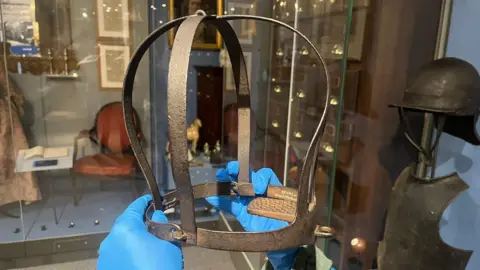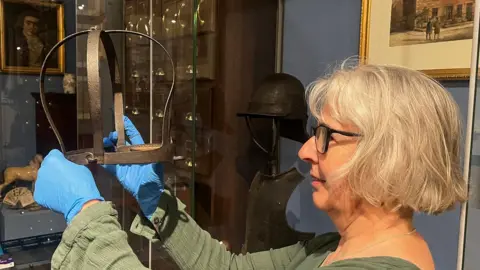Historical anti-gossip torture device goes on show
 Leeds Museums and Galleries
Leeds Museums and GalleriesAn historical contraption used as a brutal punishment for gossip has gone on display as part of a local history exhibition.
The scold's bridle – a solid iron device worn over the head - is being exhibited in Leeds.
Kitty Ross, the city's museums and galleries' curator of social history, said the items gave visitors a chance to find out more about the city's hidden past.
She said: "It's difficult to imagine a device as brutal and cruel as the scold's bridle being used in towns and cities around the country.
"It's very clearly a relic from a time when the concepts of both human rights and equality were very different to what they are today.
"Displaying these types of objects is an important, tangible reminder of how far society has come as well as an opportunity to reflect on the challenges faced by people who lived during an age when such an inhumane contraption was seen as an acceptable form of punishment."
Used in English towns and cities as early as 1574, scold's bridles were employed to discourage individuals, usually women, who were judged to have spoken rebelliously, inappropriately or out of turn.
Historians at Leeds City Museum, where the object is on show, believe their bridle was made in the 17th Century.
 Leeds Museums and Galleries
Leeds Museums and GalleriesThey were also known as a branks, or witch's bridles. The iron frame would encase the victim's head, with a roughened iron plate located near the mouth.
The plate would be placed in the mouth so the victim could not move their tongue and the wearer would then be led through the streets on a chain held by one of the town's officials.
In some towns, wearers would even be chained to a pillory, whipping post or market cross.
The Leeds example was collected by Georgian historian Norrison Scatcherd, who lived in Morley.
It is on display in the museum's Leeds Story gallery, which is a changing display of finds from the city.
 Leeds Museums and Galleries
Leeds Museums and GalleriesThe recent update to the exhibit also includes a silver cup made by Leeds goldsmith turned counterfeiter Arthur Mangey, which goes alongside a set of his coin-clipping shears.
Mr Mangey was commissioned to make a silver gilt mace by Leeds City Council in 1694, but was later accused of forgery and hanged in York in 1696.
Other exhibits include a Pudsey peace jug, made by local potter John Sugden in 1801 to mark Napoleon's signing of the Concordat of 1801 with Pope Pius VII, and a bell that once hung in Leeds's Coloured Cloth Hall in 1758.
Listen to highlights from West Yorkshire on BBC Sounds, catch up with the latest episode of Look North.
